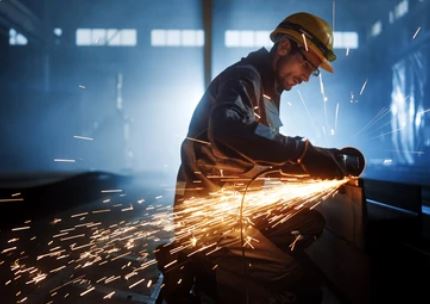The Factories Act Of 1948 & Its Applicability
COMPLIANCE CHECKLIST UNDER THE FACTORIES ACT

1. Licensing of Factory (Section 6)
The occupier of the factory requires prior permission from the State Government or the Chief Inspector in writing to establish a factory. The occupier has to send notice to the Chief Inspector before 15 days of using the premises as the factory for obtaining the licence for the factory under Section 7 of the act. The notice should contain the following details:
- Name and address of the occupier
- Name and address of the factory
- Name and owner of the premise
- Address for communication
- Nature of the manufacturing unit of the factory
- Total power to be installed
- Name of the manager in the factory
- Number of workers to be employed
2. Health Provisions (Chapter III)
Every factory must be clean and free from dirt accumulation. Floors, windows, passages, workroom benches, passages, and other surfaces should be disinfected on a regular basis. The walls should be painted once every five years.
The factory must have proper arrangements for waste and effluent treatment.
The factory premises must be properly ventilated to allow the circulation of fresh air. The walls and roofs should be of such high quality that a reasonable temperature must be maintained for comfortable working conditions.
If the work carried out in factories is such that dust and fumes are released in substantial quantities, effective measures should be taken to prevent their accumulation in any workroom.
If the humidity in any factory is increased artificially, the water used for this purpose should be taken from a public water supply or should be purified before it is used.
No room in any factory shall be overcrowded to the extent that it becomes injurious to the health of the workers employed in the factory.
The working area for the workers and the passage have adequate and sufficient light, natural or artificial or both.
The factory should have a sufficient supply of drinking water.
There must be a sufficient number of latrines and urinals which are accessible to all the workers present in the factory. There should be separate latrines and urinals for males and females with proper lights and ventilation.
Every factory shall have a sufficient number of spittoons placed at a suitable and accessible place. The spittoons should be cleaned regularly.
3. Safety provisions (Chapter IV)

- The moving part of every machinery should be securely fenced. Only specially trained adult male workers wearing tight-fitted cloth are allowed to examine the machinery when required. Only a fully instructed person having knowledge of the threats arising from the machine and precautions to be observed shall be allowed to work on dangerous machines under the supervision of an experienced person.
- An appliance should be provided and maintained to move driving belts to and from fast and loose pulleys. No self-acting machine shall be kept in such a space over which any person is liable to pass. Every set, screw, bolt or key in all machinery driven by power and installed in a factory should be encased effectively to prevent danger.
- Every hoist and lift should be safe, strong, and well-maintained.
- All lifting machine parts, including chain, rope, and lifting tackle, should be of good construction, sound material, and free of defects. They should be thoroughly inspected at least once every 12 months by a competent officer.
- Revolving machinery must be permanently attached to or placed, and a notice indicating the minimum safe working area around the machinery must be posted.
- If a factory uses machinery that operates at a pressure higher than atmospheric pressure, the pressure should be monitored.
- All floors, stairs, and passages must be properly built and maintained.
- Any vessel, tank, or pit on the floor that could be a hazard must be securely covered or fenced.
- The workers in the factory should not be forced to carry or move any load that could cause them harm.
- The workers should be provided with suitable goggles or effective screens while working in the factory which involves a risk of eye injury from particles or fragments.
- The workers should not be allowed to enter any confined space until precautionary measures to remove such fumes and gases have been taken.
- The portable electric light with a voltage of more than 24 volts should not be used in any confined space, chamber, or tank.
- All precautions should be taken to avoid an explosion of gases that are likely to explode when ignited.
- The factory should take all practical measures to prevent a fire from starting and spreading, both inside and outside the factory. In the event of a fire, people should have a safe way out of the factory.
- The factory should be properly maintained so that it does not endanger the workers’ health.
- When the number of employers in a factory exceeds 1000, the factory is required to appoint a safety officer.
4. Welfare Provisions (Chapter V)
The male and female workers should be provided with separate and clean and conveniently accessible facilities. The factory should provide a proper place for drying wet clothes or keeping extra clothes. The workers should be given a proper restroom and first-aid boxes.
A minimum of one canteen should be maintained by the occupier for more than 250 workers working in the factory. The arrangement for adequate restrooms, lunch rooms and drinking water should be made available for more than 150 workers working in the factory.
The factory should provide a suitable room for the use of children under the age of 6 years if the factory has more than 30 women workers whereas a welfare office should be maintained for more than 500 employers.
5. Working Hours of Adults (Chapter VI)
The workers are not allowed to work in a factory for more than 48 hours a week. They should not be forced to work for a continuous period of 10 days without any holiday. The worker should not be made to work on the first day of the week unless he has or will have a holiday on one of the 3 days immediately before or after the said day.
The worker should be allowed to take a holiday within two months if the worker has worked on the weekly holiday as compensation. The workers should not be allowed to work more than 9 hours in a day without the previous approval of the Chief Inspector.
The workers are allowed to take an interval of at least half an hour after working for 5 hours. The workers are not allowed to work for more than ten and a half hours a day including intervals for rest. The working hours of the worker on the night shift should be counted in the previous day.
The worker has to be paid twice the rate of his original wages if they work for more than 48 hours in any week. A worker should not be allowed to work in more than one factory. A register should be maintained in the factory to keep records of the name of the worker, and the nature of his work.
6. Employment for young persons (Chapter VII)
The child under the age of 14 years is prohibited to work in any factory. But after the fourteenth year, an adolescent child before attaining the age of majority should not be allowed to work in a factory without a certificate of fitness granted to him under Section 69 of the Act with the consent and guidance of the manager of the factory and the guardian of the adolescent. The children are not allowed to work more than four and a half hours in a day and also should not be allowed to work at night.
A register should be maintained in the factory to keep the records of the name of the child worker, the nature of his work, the age group, the shift of his group and his certificate of fitness. The child worker should not be allowed to work in the factory until his name is entered in the register of child workers to maintain his record. But an adolescent child worker can work in the factory from 6 am to 7 pm only after obtaining a certificate of fitness.
7. Annual Leave with Wages (Chapter VII)
The workers should be allowed to have leaves with wages if they have worked for a minimum of 240 days in a year in a factory in the previous year. The workers are entitled to get wages if the workers have taken leaves under Section 79 or 80 of the Act.
A worker who has been granted leave for less than four days, in the case of an adult and five days in the case of a child, should be paid the wages due for the period of leave granted before the leave begins.
Author: Neelam Prusty and Ajay Kacher, in case of any queries please contact/write back to us at support@ipandlegalfilings.com or IP & Legal Filing.


